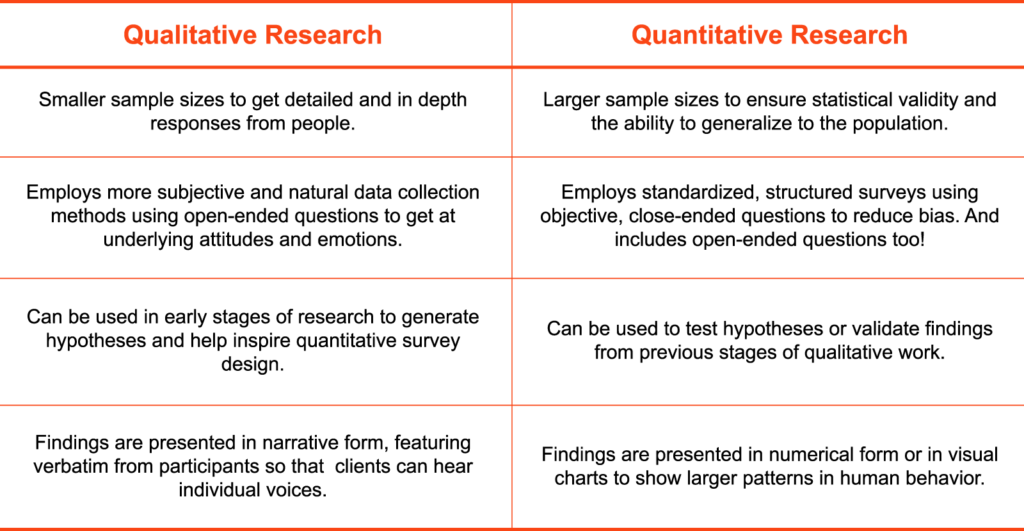I don’t know about you, but I’m super bored. Bored with the same old qualitative vs quantitative research debate. The whole… “I can do anything you can do better. I can do anything better than you. No you can’t! Yes, I can!”…song and dance.
Here’s how it typically goes:
- Qualitative research is better because you study a smaller group of people and drill deeper into why people think, feel, and do what they do.
- No, quantitative research is better because it uses larger sample sizes to ensure statistical validity so we can generalize to a larger population.
- Qualitative research is better because it uses more natural and human data collection techniques, like interviews and focus groups, to explore people’s underlying attitudes and emotions to get to richer insight.
- No, quantitative research is better because it uses structured surveys to help reduce bias and human subjectivity.
- Qualitative research is better because it can be used at the early stages of research when little is known about a topic to generate hypotheses and refine research questions.
- No, quantitative research is better because it’s confirmatory and can validate or test hypotheses so clients can make data-driven decisions and forecast trends.
- Qualitative research is better because findings are presented in narrative form, using quotes and models, so clients can relate to the story on a more human level.
- No, quantitative research is better because findings are presented in tables, charts, and graphs, so learnings are much easier for clients to interpret and share.
Back and forth… and back and forth… like a superfluous tennis match I am not at all interested in watching. Please tell me this isn’t still happening. It’s nearly 2024. I can’t, I just can’t. It’s exhausting.
In fact this very topic, “qualitative vs quantitative research”, according to our friend Google, has been referenced about 435,000,000 times. How original. So let’s start where I would guess 99% of these articles started from… and look at what makes qualitative and quantitative research different (cue standard definitions in any marketing research 101 textbook that has ever been published).
What is qualitative research?
Traditionally, “qualitative research” is defined as a research method that focuses on exploring and understanding the underlying meanings, motivations, and behaviors of individuals or groups. It focuses on gathering subjective and descriptive (aka non-numerical) data about human behavior, attitudes, and perceptions, related to products, services, brands, or marketing strategies. It aims to understand the “why” and “how” behind people’s choices and behaviors by digging into their lived experiences.
Researchers tend to use methods like in-depth interviews, focus groups, and ethnography to collect qualitative data. These methods encourage people to express themselves freely and provide detailed responses, allowing researchers to explore people’s emotions, motivations, and decision-making processes.

What is quantitative research?
Again traditionally, “quantitative research” is defined as a systematic empirical investigation that gathers data to provide evidence for understanding, explaining, and predicting human phenomena. It’s primarily concerned with obtaining numeric information, such as numerical values and percentages to understand and measure various aspects of behavior.
Researchers and consultants tend to use structured surveys, and other standardized data collection methods, that aim to gather objective data that allows for numerical analysis and statistical testing. It is often used to answer questions related to “how much,” “how many,” or “to what extent.””
If you’ve been in the marketing research world as long as I have, these very standard definitions of qualitative and quantitative research will not be new news to you. Even though the world has changed, clients’ needs have changed, people have changed, the defining characteristics of these two research dinosaurs haven’t changed a heck of a lot within the wider world of research. However, at The Sound, we have a slightly different take. More on that later.
So if the differences are obvious and the use cases are clear… as an old qualie, naturally my first question is… why the debate? Why qualitative research vs quantitative research? Why do we keep pitting them against each other? Like two kids at the playground fighting for the last swing. Well, when two people (or in this case two research disciplines) continue to battle it out, it often stems from 3 things:
- Insecurity. Like most other industries, the demand for marketing research services fluctuates based on economic conditions. During economic downturns or periods of uncertainty (uh, like now!), businesses are forced to reduce their marketing budgets… because they too are trying to survive the shit storm.
- Scarcity. Smaller marketing budgets leads to less comprehensive research, reducing the number of opportunities available… hence increasing competition between agencies (and methodologies). This competition contributes to a perception of scarcity, particularly for small to medium sized businesses.
- Change. The marketing landscape is constantly evolving, with new channels, technologies (um, hello AI), and market behaviors emerging. Professionals who stay updated on industry trends and adapt to new methodologies are laughing… those who don’t risk falling by the wayside.
So yes, we’ve all been on the struggle bus. But let’s not lose the plot here. A lot of these things we can’t control as research agencies and professionals but what we can control is our reaction to them (you can thank my therapist for that one). So let’s do something different and talk about how they are the same.

What do qualitative research and quantitative research have in common?
The irony of it all is that qualitative research and quantitative research have more in common than one might expect. Let’s take a moment to drill… it… all… the… way… down… to… the… basics.
As researchers and consultants, what do we always start with? Well, it’s typically two things:
- A client with a business objective.
- A group of people to study.
Let’s start with the first one. A client with a business objective. Clients tend to come to a research partner with a desire to do something. To develop a new product, acquire a new audience, launch a new campaign, whatever it is. And in order to do this thing they want to do they need information to make decisions. Because making uninformed decisions is just… well, not very smart.
That’s where the people part comes in. In order to gather the information, we need to go straight to the source. People. The people who buy the dish soap, use the food delivery service, or download the dating app. And until Elon Musk invents a sure-fire way to read people’s minds in order to get information from people (scary), we need to ask them questions. Questions about their thoughts, feelings, behaviors, experiences, perceptions, desires, fears, insecurities… all of it.
- How are you feeling about your life right now?
- What is the main idea behind Concept F?
- What grocery stores do you prefer to shop at?
- Why haven’t you purchased the iPhone 15 Pro?
The reality is, regardless of whether you’re running qualitative research or quantitative research, the questions are typically the same. It’s how we ask the question that can differ. Sometimes it’s an open ended question during an in-home ethnography in someone’s living room. And sometimes it’s a closed ended question on the 5-pt likert scale. It doesn’t really matter. It’s still a human being asking a human being a question so that another human being can make a decision that will impact even more human beings. Picking up what I’m putting down?
So whether it’s qualitative research or quantitative research, our intentions don’t change (or at least they shouldn’t change). We are both trying to understand people to help our clients make business decisions. As Simon Sinek says “If you don’t understand people, you don’t understand business.” But what does change is our perspective. The perspective from which we approach understanding people.
From a quantitative research perspective, we tend to look at people from the top down. Quant starts by listening to the stories of 1000 people at the same time… then we break it down, examine the pieces, and put it back together again.
From a qualitative research perspective, we tend to look at people from the ground up. Qual starts by listening to one person’s story, then another, then another… then we analyze for themes and ladder up to insights.
But both lead to the same place. Insight about people. And insight leads to strategic recommendations. And strategic recommendations lead to smart decision making. And smart decision making leads to better products and services for people. Don’t you love it when things come full circle?
Qualitative research vs quantitative research… So, which is better then?
The answer is, both are better. More specifically, both are better together. Here’s what I mean. You would never suggest someone smell a rose with their eyes closed. Or taste a fresh strawberry while plugging their nose. Because essentially you would be cutting them off from having the full experience of whatever it is they’re doing.
Similarly, quantitative research and qualitative research offer a unique perspective of the same phenomenon. So by finding ways to employ both quantitative and qualitative research, we are opening ourselves (and our client) up to more stimulus, more data, more insight… and more opportunities to take action. This is what helps all of us become better research partners and marketers.
In fact, when we look more closely at this “qualitative vs quantitative research debate”… their differences complement each other. Each naturally compensates for what the other doesn’t provide.

As such, it is important that we don’t get stuck in old research tropes around what qualitative and quantitative research is and isn’t, and what each can and can’t do. Qualitative research is more than just subjective storytelling. It is the rigorous analysis of hundreds of data points. And quantitative research can do more than just tell clients how much or how many. It can reveal insight into why people do the things they do or feel the way they feel. At The Sound we believe that behind every data point (whatever form it comes in… numbers, words, picture, video, voice) is a person, a story to be told. A human story.
In summary, just like any situation where we use multiple vantage points to examine the same phenomenon… there are huge advantages to using both quantitative and qualitative research. Here’s just a few of them:
- Enhances Understanding: Exploring an audience from two different research perspectives provides us with a more comprehensive and nuanced understanding of their lived experience… which leads to deeper insights for our clients… and greater empathy!
- Improves Problem Solving: Exploring an audience from two different research perspectives can reveal solutions or approaches to solving a client’s business problem we would have never spotted alone. It gives us an opportunity to brainstorm together, weigh out different viewpoints, and help our clients make more informed and well-rounded decisions.
- Reduces Bias: Exploring an audience from two different research perspectives, we are less likely to be influenced by our personal biases or preconceptions. We can use each other to poke (and fill) holes in our findings and develop a more honest, comprehensive story.
- Sparks Innovation: Exploring an audience from two different research perspectives can foster innovation and help us come up with novel ideas that cater to a broader audience.
- Increases Adaptability: Exploring an audience from two different research perspectives can make us more adaptable as researchers and consultants. We can adjust your strategies, plans, and approaches based on new information… and most importantly, we can learn from each other.
So, you see? We both like puzzles. People puzzles. It’s just how qualitative research and quantitative research approach solving them is a bit different. So, let’s drop the pretense. Drop the debate. Drop the drama. And recognize that we need both quantitative research and qualitative research to work together to help our clients achieve their business outcomes.
Have some research questions you’d like answered? We’re here to help.


